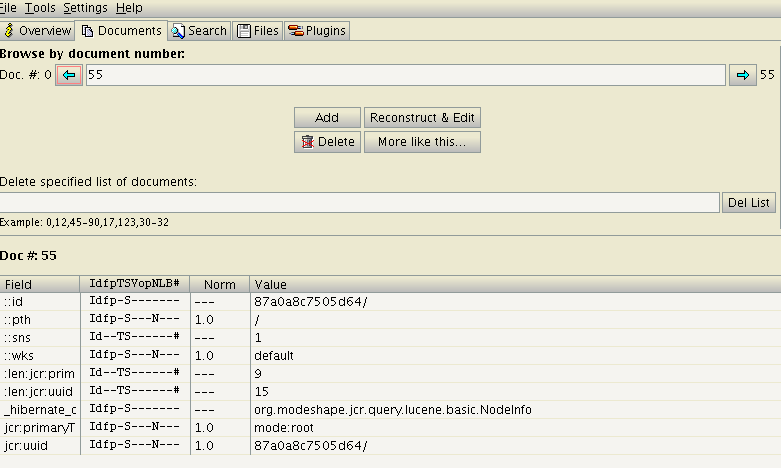
Walkthrough
The following steps simulate a typical user session. An end result (i.e a layout of file and directories) is then shown.
The user creates a node ('greetings_en') through the UI and uploads content – in this example it's a simple text file (fcrepo4_greetings.txt) with a string ("hello, world!"):
The modeshape configuration specifies using a file-based backend store.
cd fcrepo4/fcrepo-webapp mvn jetty:run -Dfcrepo.modeshape.configuration=classpath:config/single-file/repository.json |
curl -X PUT --data-binary "@fcrepo4_greetings.txt" "http://localhost:8080/rest/greetings_en/ds0/fcr:content" |
Fedora will create a directory "fcrepo4-data" in the current working directory. The default directories found in "fcrepo4-data" will be the following:
> ls fcrepo4-data com.arjuna.ats.arjuna.common.ObjectStoreEnvironmentBean.default.objectStoreDir com.arjuna.ats.arjuna.objectstore.objectStoreDir fcrepo.activemq.dir fcrepo.ispn.repo.CacheDirPath fcrepo.modeshape.index.location |
"fcrepo.ispn.repo.CacheDirPath" contains the generated data files. "fcrepo.modeshape.index.location" contains the Lucene index.
The serialized Fedora nodes can be found in the "fcrepo.ispn.repo.CacheDirPath/FedoraRepository" directory. The files in that directory would look something like this:
> ls fcrepo4-data/fcrepo.ispn.repo.CacheDirPath/FedoraRepository/ -891938816 1008466944 1016939520 102151168 1036310528 ... |
The generated files contain serialized data about each of the JCR/Fedora nodes. Running the cURL command above, for example, creates hundreds of binary files.
Some key things to note about the files and their contents:
The file names in the case of FileCacheStore are just signed 32-bit integers, so the usual and maximum length of file names is 10 or 11 characters. The file names (i.e. integers) are generated by calculating the Java hashCode of the node's UUID string (prefixed with root node UUID and masking it by a 22 fixed bit mask). For example, the following Java snippet code calculates the file name for root node (UUID "87a0a8c75085d64/"):
fileName = "87a0a8c7505d64/".hashCode() & 0xfffffc00; //equals -891938816 |
Therefore, file -891938816 would contain data about the root node.
Each of the files contain serialized ModeShape nodes. Although the generated files are binary, using a tool (a simple utility is under development) can help in reading the contents of the file (It might not be easy to read these files using mongoDB bsondump alone). For example, for our root node file (-891938816) , a tool might display the root node data in JSON as following:
{ "properties" :
{ "http://www.jcp.org/jcr/1.0" :
{ "primaryType" :
{ "$name" : "mode:root" } , "uuid" : "87a0a8c7505d64/"
}
} ,
"children" :
[ { "key" : "87a0a8c317f1e7jcr:system" , "name" : "jcr:system" } ,
{ "key" : "7c366d9-25bc-4e2d-9e53-4428fe7b8152" , "name" : "greetings_en" } ] ,
"childrenInfo" : { "count" : 2 }
} |
As an aside, a tool could be written to show the full file-to-content mapping; the utility under development aims to display this information like the following snippet:
-891938816 UUID 87a0a8c7505d64 mode:root -1857312768 UUID 7c366d9-25bc-4e2d-9e53-4428fe7b8152 greetings_en 328781824 UUID 7e84184d-3a8e-4f57-8e49-a550f1c19b3a greetings_en/ds0 39043072 UUID fc859bab-6f7b-46de-9b4c-f40dfe28643c hello, world! |
The data is encoded in Binary JSON (BSON). If the file containing the root node (referencing the node 'greetings_en') is opened up in a hex editor, you would see /u0002 preceding strings (such as "name","key"); /u0004 preceding an array (representing sub-nodes); /u0003 representing the UUID -- in accordance with the BSON spec.
\u0000\u0000\u0000\u0004children\u0000ü\u0000\u0000\u0000\u00030\u0000<\u0000\u0000\u0000 \u0002key\u0000\u0019\u0000\u0000\u000087a0a8c317f1e7jcr:system\u0000\u0002name\ u0000\u000B\u0000\u0000\u0000jcr:system\u0000\u0000\u00031\u0000X \u0000\u0000\u0000\u0002key\u00003\u0000\u0000\u000087a0a8c7505d6417c366d9-25bc-4e2d-9e53-4428fe7b8152\u0000\u0002name\u0000\u0000\u0000\u0000greetings_en\u0000\u0000\u0000\u0003childrenI |
87a0a8c7505d641/7org.infinispan.schematic.internal.SchematicEntryLiteral6org.infinispan.marshall.jboss.JBossExternalizerAdapterq externalizer$org.infinispan.marshall.ExternalizerDorg.infinispan.schematic.internal.SchematicEntryLiteral $Externalizer7org.infinispan.schematic.internal.SchematicExternalizer8org.infinispan.schematic.internal.document.BasicDocument;?org.infinispan.schematic.internal.document.DocumentExternalizer2; 23metadata?id87a0a8c7505d64/contentTypeapplication/jsoncontent>propertiesghttp://www.jcp.org/jcr/1.0FprimaryType$namemode:root3uuid 87a0a8c7505d64/children04<key87a0a8c317f1e7jcr:systemnamejcr:system1key387a0a8c7505d6417c366d9-25bc-4e2d-9e53-4428fe7b8152name greetings_en5childrenInfocount556 |
Key elements are annotated:
87a0a8c7505d64 refers to node UUID
The grayed out text refers to Modeshape classes responsible for data representation and serialization. The JBoss Marshalling serialization format contains the name of datastructures i.e. custom marshallers in org.infinispan.schematic.internal.*
The file contains binary data for specifying different internal attributes, so when opened up in an ordinary text editor, the text editor might show some numbers as garbage characters. These numbers have meaning for node's attributes, though. For example, the highlighted entry #4 specifies an array of the children of a node. The index number of the child precedes its key and name. So, if object "greetings_en" gets another sibling "greetings_fr", the latter's entry would be preceded by 2 (its index). The full children node array would now appear something like:
/children0<key87a0a8c317f1e7jcr:systemnamejcr:system 1Xkey387a0a8c7505d6417c366d9-25bc-4e2d-9e53-4428fe7b8152namegreetings_en 2Xkey387a0a8c7505d64aa21b2ee-d22a-4b0a-8b43-a8e8b58c5ec6namegreetings_fr |
Similarly, for the datastream content (omitting ModeShape API artifacts):
87a0a8c7505d64fc859bab-6f7b-46de-9b4c-f40dfe28643c1 . . .2 metadatabid387a0a8c7505d6 4fc859bab-6f7b-46de-9b4c-f40dfe286433ccontentTypeapplication/ jsoncontent4Ékey387a0a8c7505d64fc859bab-6f7b-46de-9b4c- f40dfe28643c3parent387a0a8c7505d647e84184d-3a8e-4f57-8e49-a550f1c19b3a5properties ̃http:// www.jcp.org/jcr/1.0"primaryType$name nt:resourcedatahello, world!6 lastModified.$date2013-12-09T23:51:00.520-05:007mixinTypesL0D$name4{http://fedora.info/ definitions/v4/rest-api#}binarylastModifiedBy bypassAdmin8mimeTypeapplication/octet-stream9http://fedora.info/definitions/v4/rest-api#NdigestA $uri2urn:sha1:e91ba0972b9055187fa2efa8b5c156f487a8293a10http://www.loc.gov/premis/rdf/ v1#hasSize55 |
Some of the elements of interests are:
ModeShape currently makes use of Hibernate Search to manage Lucene indexes. The indexes can be viewed by using Luke, e.g.
These files can be found in the "fcrepo.modeshape.index.location" directory.

Directories "com.arjuna.ats.arjuna.objectstore.objectStoreDir" and "com.arjuna.ats.arjuna.common.ObjectStoreEnvironmentBean.default.objectStoreDir" are JBoss JTA transaction engine artifacts. The default Fedora Infinispan configuration attempts to find a JBossJTA transaction manager implementation via "org.infinispan.transaction.lookup.GenericTransactionManagerLookup". This configuration uses Arjuna ShadowFileStore as a backend, resulting in several directories within fcrepo4-data such as "object-store" and "object-store-default":
|-object-store |---ShadowNoFileLockStore |-----defaultStore |-------Recovery |---------TransactionStatusManager |-object-store-default |---ShadowNoFileLockStore |-----defaultStore |
A detailed description of the artifacts maintained by the JBossJTA implementation is most likely beyond the scope of this document (at least for now).
Depending on the configured Infinispan backend, the directory layout and contents of the binary files would be different. The following sections covers other cache store options.
Currently, the default configuration outputs Fedora data to LevelDB (a fast filesystem based key-value store). When Fedora 4 is started, ModeShape (actually Infinispan and LevelDB in the background) will create several directories on the filesystem. Currently, the directories created are:
The layout of files in directories 1-3 is determined by LevelDB. Some of the important files are:
As is the case with the FileCacheStore, the .log files are binary. The default initial .log file is 000003.log, and it contains serialized entries for all the nodes from recent transactions. If the repository has only a few hundred added nodes, this file will contain all the nodes (i.e. the additions and default properties like mix:etag).